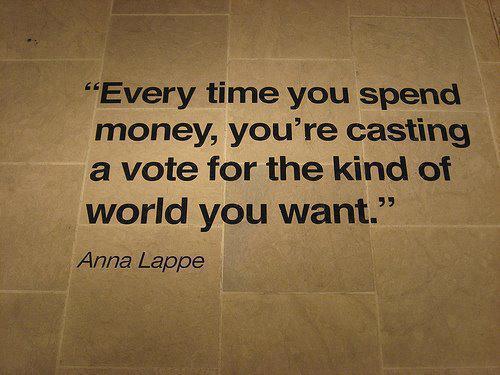Power is the
ability to create change by mere influence or suggestion. Marketing a product involves some sort of
power; influence must be created so the buyer wants to use the product. Thus, power involves money. Within Berger’s “Way of Seeing,” there are
numerous supporting details that support the idea of power to the elitists
within society. For example, Berger
argues, “Publicity is the culture of the consumer society” (Berger 139)
therefore meaning the consumer must
have money to remain elite within the society.
Hall calls power politics, since many important ideas in society stem
from politics and how these ideas are seen.
The representation, or way of
showing off a product/object/idea, creates appeal that makes the public want to
buy the product. Our own opinions, our way of looking, also alter the way we
view people/products within the society. The quote below is true in many instances.
 |
| positiwitty.com |
Through these opinions popular
culture is created. Popular culture
is a thought or idea that is made famous through a multitude of people’s
opinions. The consumption of information is what creates pop culture. These
opinions follow the same trend and create a mass media phenomenon and a mass
consumption of information. Popular
culture can involve objects, many of
them materialistic. For example, the
iPhone was one of the most popular electronic devices of 2012. On Google News, the iPhone is always one of the trending topics. This is due to Apple’s popularity in the
electronic world and the way Apple showcased its products to the public. Popular culture can make or break an image of
a perfect product/person.
 |
| forbes.com |
Sexism plays a
major role in the way people view each other and the world. Women are sometimes seen as objects instead
of people, creating a harsh stereotype.
In Hall’s argument, Black men are seen as “childlike and oversexed”
(Hall). This is similar to women being
seen as subservient to men in early advertising. Sexism is created by a sense of inequality.
Hegemony is
creating a dominion through the usage of force.
Within bell hooks’ “Representing Whiteness,” hooks argues that all Black
people within the US will be harassed by the “whiteness” of society. This, according to hooks, stems back to the
Jim Crow south. This is supportive of
many movies and film. This hegemony has
tried to create a nation where whites are dominant to the minority. This is not the case. Since reading “Native Son” by James Baldwin,
the character of Bigger Thomas, a young Black boy, is seen as having this
“whiteness.” Bigger is able to avoid
being caught because he played into the stereotype of being a typical Black
boy. This stereotype is negative and slight
blunder causes Bigger his life, merely because he is Black.
Stuart Hall explains that this has “polarized into…extreme
opposites” (Hall 146). Hall goes on
further to explain the instability of Haiti, a predominately Black nation. Hall also explains that these stereotypes
paint of stereotypical picture of what some whites seen Blacks to be. This creates a separation of classes and the
creation of power. Many people like Martin Luther King Jr. and Mohandas K. Gandhi fought to end these stereotypes and hegemonies.
 |
| foodforthespiritualsoul.wordpress.com |
Today, many people who have expensive products are
considered upper class. These people are
considered to be powerful. Celebrities
and athletes fall within these categories and are usually created by the
general public. Most singers are
probably created this way since one famous song can lead to the public’s
interest in the singer’s other albums.
Advertising is much more eye-catching to the public if a physically fit
person is advertised with a product. Sometimes
the person has nothing to do with the product.
We buy what we feel is worth buying and this is generated through our
own opinions. Through all of this
imagery, we are able to create the world around us and create our own public
images.
 |
| tumblr.com/tagged/anna-lappe |
No comments:
Post a Comment
Note: Only a member of this blog may post a comment.